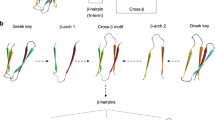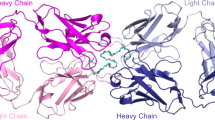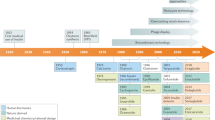Abstract
We describe a structural validation of the use of presentation scaffolds for control and elucidation of bioactive conformations of peptides. The protein REI-RGD34—produced by inserting the sequence RIPRGDMP into the CDR1 loop region of the immunoglobulin VL domain REI—strongly inhibits fibrinogen binding to the integrins αIIbβ3 and αVβ3. In the X-ray crystal structure of this protein at 2.4 Å resolution, the RGD-containing loop exhibits defined electron density that is consistent with models for the bioactive conformations of ligands of these receptors based on previous small-molecule studies. Furthermore, a search of a small- molecule database with conformational information derived from the structure of REI-RGD34 identified constrained peptides and peptidomimetics known to be antagonists of the platelet receptor αIIbβ3.
This is a preview of subscription content, access via your institution
Access options
Subscribe to this journal
Receive 12 print issues and online access
$189.00 per year
only $15.75 per issue
Buy this article
- Purchase on Springer Link
- Instant access to full article PDF
Prices may be subject to local taxes which are calculated during checkout
Similar content being viewed by others
References
Clackson, T. & Wells, J.A. In vitro selection from protein and peptide libraries. Trends Biotech. 12, 173–184 (1994).
Wetzel, R., Commentary: Learning from the immune system; laboratory methods for creating and refining molecular diversity in polypeptides. Protein Engng. 4, 371–374 (1991).
Scott, J.K. Discovering peptide ligands using epitope libraries. Trends biochem. Sci. 17, 241–245 (1992).
O'Neil, K.T. et al. Identification of novel peptide antagonists for GPIIb/llla from a conformationally constrained phage peptide library. Proteins 14, 509–515 (1992).
Taub, R. & Greene, M.I. Functional validation of ligand mimicry by anti-receptor antibodies: Structural and therapeutic implications. Biochemistry 31, 7431–7435 (1992).
Lee, G. et al. Strong inhibition of fibrinogen binding to platelet receptor αIIbβIII by RGD sequences installed into a presentation scaffold. Protein Engng. 6, 745–754 (1993).
Maeda, T. et al. A novel cell adhesion protein engineered by insertion of the Arg-Gly-Ser tetrapeptide. J. biol. Chem. 264, 15165–15168 (1989).
Freimuth, P.I., Taylor, J.W. & Kaiser, E.T. Introduction of guest peptides into Escherichia coli alkaline phosphatase. J. biol. Chem. 265, 896–901 (1990).
Sollazzo, M., Billetta, R. & Zanetti, M. Expression of an exogenous peptide epitope genetically engineered in the variable domain of an immunoglobulin: implications for antibody and peptide folding. Protein Engng. 4, 215–220 (1990).
Wolfson, A.J., Kanaoka, M., Lau, F.T.K. & Ringe, D. Insertion of an elastase-binding loop into interleukin-1β. Prot. Engng. 4, 313–317 (1991).
Zaghouani, H. et al. Presentation of a viral T cell epitope expressed in the CDR3 region of a self immunoglobulin molecule. Science 259, 224–227 (1993).
Pessi, A. et al. A designed metal-binding protein with a novel fold. Nature 362, 367–369 (1993).
Dennis, M.S. et al. Platelet glycoprotein iib-iiia protein antagonists from snake venoms: evidence for a family of platelet-aggregation inhibitors. Proc. natn. Acad. Sci. U.S.A. 87, 2471–2475 (1989).
Helms, L.R. & Wetzel, R. Destabilizing loop swaps in the CDRs of an immunoglobulin VL domain. Prot. Sci. 4, 2073–2081 (1995).
Chothia, C. et al. Conformations of immunoglobulin hypervariable regions. Nature 342, 877–883 (1989).
Tramontano, A., Chothia, C. & Lesk, A.M. Structural determinants of the conformations of medium-sized loops in proteins. Proteins Struct. Funct. Genet. 6, 382–394 (1989).
Saudek, V., Atkinson, R.A. & Pelton, J.T. Three-dimensional structure of echistatin, the smallest active RGD protein. Biochemistry 30, 7369–7372 (1991).
Adler, M., Lazarus, R.A., Dennis, M.S. & Wagner, G. Solution structure of kistrin, a potent platelet aggregation inhibitor and gp IIb-IIIa antagonist. Science 253, 445–448 (1991).
Main, A.L., Harvey, T.S., Baron, M., Boyd, J. & Campbell, I.D. The three-dimensional structure of the tenth type III module of fibronectin: an insight into RGD-mediated interactions. Cell 71, 671–678 (1992).
Dickinson, C.D. et al. Crystal structure of the tenth type III cell adhesion module of human fibronectin. J. molec. Biol. 230, 1079–1092 (1994).
Yamada, T. et al. Structural and functional analyses of the Arg-Gly-Asp sequence introduced into human lysozyme. J. biol. Chem. 268, 10588–10592 (1993).
Leahy, D.J., Hendrickson, W.A., Aukhil, I. & Erickson, H.P. Structure of a fibronectin type III domain from tenascin phased by MAD analysis of the selenomethionyl protein. Science 258, 987–991 (1992).
Krezel, A.M., Wagner, G., Seymour-Ulmer, J. & Lazarus, R.A. Structure of the RGD protein decorsin: conserved motif and distinct function in leech proteins that affect blood clotting. Science 264, 1944–1947 (1994).
Kodandapani, R., Veerapandian, B., Kunicki, T.J. & Ely, K.R. Crystal structure of the OPG2 Fab. An antireceptor antibody that mimics an RGD cell adhesion site. J. biol. Chem. 270, 2268–2273 (1995).
Pfaff, M. et al. Selective recognition of cyclic RGD peptides of NMR defined conformation by alpha lib beta 3, alpha V beta 3, and alpha 5 beta 1 integrins. J. biol. Chem. 269, 20233–20238 (1994).
Barbas, C.F., III, Languino, L.R. & Smith, J.W. High-affinity self-reactive human antibodies by design and selection: targeting the integrin ligand binding site. Proc. natn. Acad. Sci. U.S.A. 90, 10003–10007 (1993).
Langen, H.T. & Taylor, J.W. Alkaline phosphatase-somatostatin hybrid proteins as probes for somatostatin-14 receptors. Proteins 14, 19 (1992).
Peishoff, C.E. et al. Investigation of conformational specificity at GPIIb/IIIa: Evaluation of conformationally constrained RGD peptides. J. med. Chem. 35, 3962–3969 (1992).
Abola, E., Bernstein, F.C., Bryant, S.H., Koetzle, T.F. & Weng, J. in Crystal log raphic Databases - Information Content Software Systems, Scientific Applications (eds. Allen, F.H., Bergerhoff, G. & Sievers, R.) 107–132 (Data Commission of the International Union of Crystallography, Bonn, Germany, 1987).
Scarborough, R.M. et al. Characterization of the integrin specificities of disintegrins isolated from American Pit Viper venoms. J. biol. Chem. 268, 1058–1065 (1993).
Lauri, G. & Bartlett, P.A. CAVEAT: a program to facilitate the design of organic molecules. J. Comput. aided molec. Design 8, 51–66 (1994).
Etzkorn, F.A., Guo, T., Lipton, M.A., Goldberg, S.D. & Bartlett, P.A. Cyclic hexapeptides and chimeric peptides as mimics of tendamistat. J. Am. chem. Soc. 116, 10412–10425 (1994).
Callahan, J.F. et al. Design and synthesis of a C7 mimetic for the predicted gamma-turn conformation found in several constrained RGD antagonists. J. med. Chem. 35, 3970–3972 (1992).
Ku, T.W. et al. Direct Design of a Potent Non-Peptide Fibrinogen Receptor Antagonist Based on the Structure and Conformation of a Highly Constrained Cyclic RGD Peptide. J. Am. chem. Soc. 115, 8861–8862 (1994).
Saragovi, H.U. et al. Design and synthesis of a mimetic from an antibody complementary-determining region. Science 253, 792–795 (1991).
Chen, S. et al. Design and synthesis of a CD4 β-turn mimetic that inhibits human immunodeficiency virus envelope glycoprotein gp120 binding and infection of human lymphocytes. Proc. natn. Acad. Sci. U.S.A. 89, 5872–5876 (1992).
Smythe, M.L. & von Itzstein, M. Design and synthesis of a biologically active antibody mimic based on an antibody-antigen crystal structure. J. Am. chem. Soc. 116, 2725–2733 (1994).
Hurle, M.R., Helms, L.R., Li, L., Chan, W. & Wetzel, R. A role for destabilizing amino acid replacements in light chain amyloidosis. Proc. natn. Acad. Sci. U.S.A. 91, 5446–5450 (1994).
Smith, J.W., Ruggeri, Z.M., Kunicki, T.J. & Cheresh, D.A. Interaction of integrins αVβ3 and glycoprotein IIb-IIIa with fibrinogen: Differential peptide recognition accounts for distinct binding sites. J. biol. Chem. 265, 12267–12271 (1990).
Kopple, K.D. et al. Conformations of Arg-Gly-Asp containing heterodetic cyclic peptides; solution and crystal studies. J. Am. chem. Soc. 114, 9615–9623 (1992).
McPherson, Jr., A. The growth and preliminary investigation of protein and nucleic acid crystals for X-ray diffraction analysis. Meth. biochem. Anal. 23, 249–345 (1976).
Matthews, B.W. Solvent Content of Protein Crystals. J. molec. Biol. 33, 491–497 (1968).
Otwinowski, Z. Denzo Program Manual (Yale University, New Haven, 1994).
Brunger, A.T. X-PLOR Manual, Version 3.0 (Yale University, New Haven, 1992).
Epp, O. et al. Crystal and molecular structure of a dimer composed of the variable portions of the Bence-Jones protein REI. Eur. J. Biochem. 45, 513–524 (1974).
Jones, T.A. Interactive computer graphics: FRODO. Meth. Enzymol. 115, 157–171 (1985).
Finn, B.E., Chen, X., Jennings, P.A., Saalau-Bethell, S.M. & Matthews, C.R. Reversible unfolding of proteins: kinetic and thermodynamic analysis, in Protein Engineering (eds. Rees, A.R., Stemberg, M.J.E. & Wetzel, R.) 167–189 (IRL Press at Oxford University Press, Oxford, 1992).
Herron, J.N., He, X.-M., Mason, M.I., Voss, E.W. & Edmundson, A.B. Proteins 5, 271–286 (1989).
Kabat, E.A., Wu, T.T., Perry, H.M., Gottesman, K.S. & Foeller, C. Sequences of Proteins of Immunological Interest (U. S. Department of Health and Human Services, Public Health Service, National Institutes of Health, Washington, D. C, 1991).
Brooks, I. et al. in Modern Analytical Ultracentrifugation: Acquisition, Analysis and Interpretation of Data for Biological and Synthetic Polymers (eds. Shuster, T.M. & Laue, T.M.) 15–36 (Royal Society of Chemistry, London, 1994).
Samanen, J. et al. Development of a small RGD peptide fibrinogen receptor antagonist with potent antiaggregatory activity in vitro. J. med. Chem. 34, 311–425 (1991).
Gan, Z.-R., Gould, R.J., Jacobs, J.W., Friedman, P.A. & Polokoff, M.A., A potent platelet aggregation inhibitor from the venom of the viper, Echis carinatus. J. biol. Chem. 263, 19827–19832 (1988).
Author information
Authors and Affiliations
Rights and permissions
About this article
Cite this article
Zhao, B., Helms, L., DesJarlais, R. et al. A paradigm for drug discovery using a conformation from the crystal structure of a presentation scaffold. Nat Struct Mol Biol 2, 1131–1137 (1995). https://doi.org/10.1038/nsb1295-1131
Received:
Accepted:
Issue Date:
DOI: https://doi.org/10.1038/nsb1295-1131



